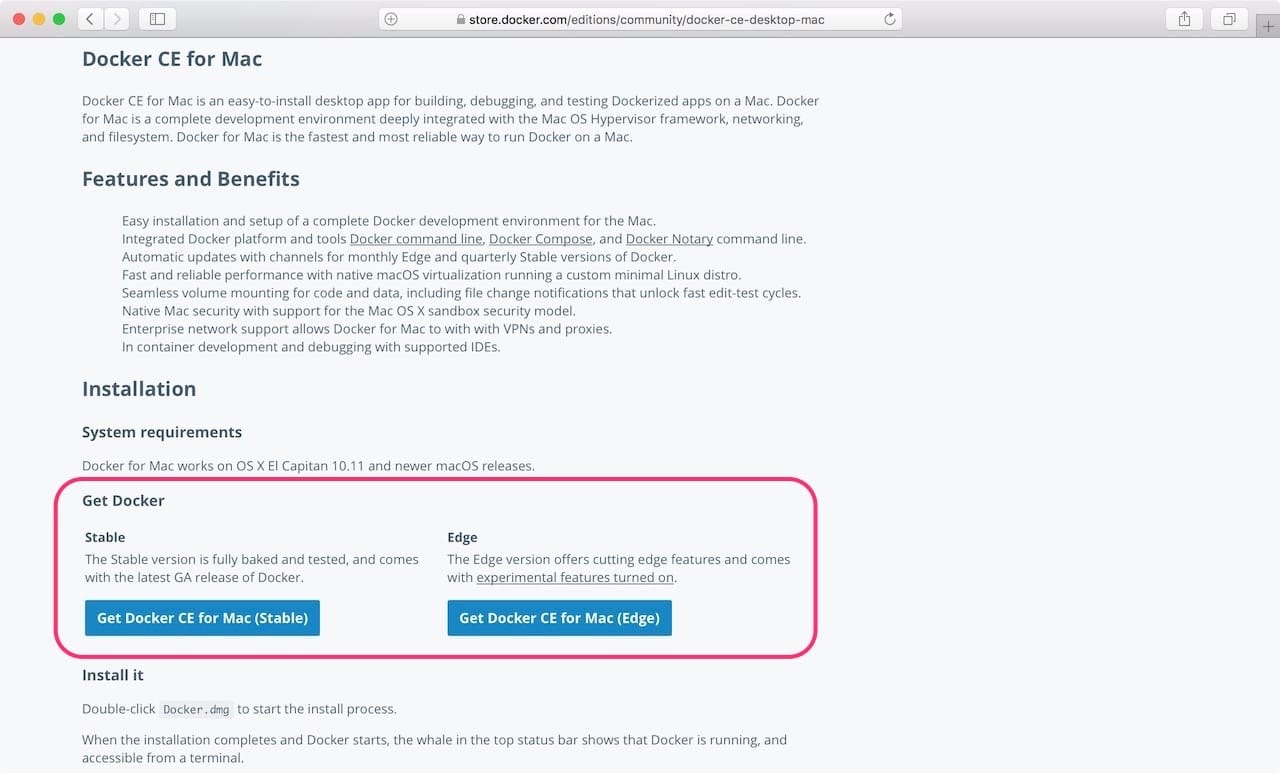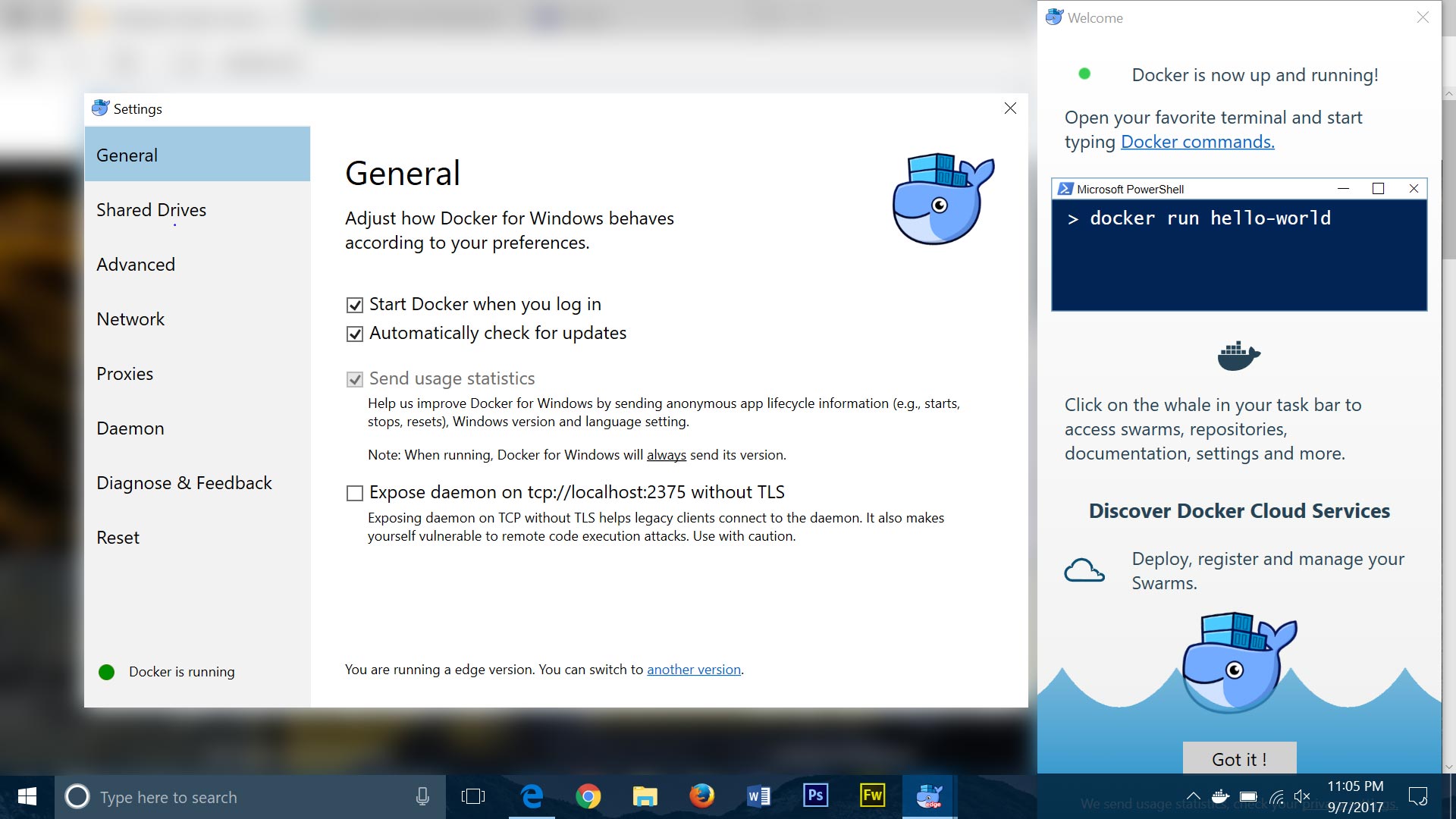Docker-ce For Mac
Install docker for mac. If it does, it will use it – and use whatever IP address and netmask are configured on this address. For instance, if you already have a bridge br0 setup with IP address 10.3.3.100/24, and start the Docker daemon with -b br0, then containers will be started on IP addresses from 10.3.3.1 to 10.3.3.99, then (skipping the bridge address) from 10.3.3.101 to 10.3.3.254.
Install Docker for Mac Estimated reading time: 3 minutes Docker for Mac is the of Docker for MacOS. To download Docker for Mac, head to Docker Store. What to know before you install README FIRST for Docker Toolbox and Docker Machine users If you are already running Docker on your machine, first read to understand the impact of this installation on your existing setup, how to set your environment for Docker for Mac, and how the two products can coexist. Relationship to Docker Machine: Installing Docker for Mac does not affect machines you created with Docker Machine. You have the option to copy containers and images from your local default machine (if one exists) to the new Docker for Mac VM.
When you are running Docker for Mac, you do not need Docker Machine nodes running at all locally (or anywhere else). With Docker for Mac, you have a new, native virtualization system running (HyperKit) which takes the place of the VirtualBox system. To learn more, see. System Requirements: Docker for Mac launches only if all of these requirements are met. Mac hardware must be a 2010 or newer model, with Intel’s hardware support for memory management unit (MMU) virtualization, including Extended Page Tables (EPT) and Unrestricted Mode. You can check to see if your machine has this support by running the following command in a terminal: sysctl kern.hvsupport.
Docker-ce For Mac

macOS El Capitan 10.11 and newer macOS releases are supported. We recommend upgrading to the latest version of macOS. At least 4GB of RAM.

VirtualBox prior to version 4.3.30 must NOT be installed (it is incompatible with Docker for Mac). If you have a newer version of VirtualBox installed, it’s fine. Note: If your system does not satisfy these requirements, you can install, which uses Oracle VirtualBox instead of HyperKit. What the install includes: The installation provides, Docker CLI client,. Install and run Docker for Mac.
Double-click Docker.dmg to open the installer, then drag Moby the whale to the Applications folder. Double-click Docker.app in the Applications folder to start Docker. (In the example below, the Applications folder is in “grid” view mode.) You are prompted to authorize Docker.app with your system password after you launch it. Privileged access is needed to install networking components and links to the Docker apps. The whale in the top status bar indicates that Docker is running, and accessible from a terminal. If you just installed the app, you also get a success message with suggested next steps and a link to this documentation.
Click the whale ( ) in the status bar to dismiss this popup. Click the whale ( ) to get Preferences and other options. Select About Docker to verify that you have the latest version.
You are up and running with Docker for Mac. Where to go next.
provides an overview of Docker for Mac, basic Docker command examples, how to get help or give feedback, and links to all topics in the Docker for Mac guide. describes common problems, workarounds, how to run and submit diagnostics, and submit issues. provides answers to frequently asked questions. lists component updates, new features, and improvements associated with Stable releases (or ). provides a general Docker tutorial.,.
You at DockerCon Europe and now it is here: we are proud to announce that Docker for Mac with beta Kubernetes support is now publicly available as part of the. We hope you are as excited as we are! With this release you can now run a single node Kubernetes cluster right on your Mac and use both kubectl commands and docker commands to control your containers. First, a few things to keep in mind:.
Docker for Mac required Kubernetes features are only accessible on macOS for now; Docker for Windows and Docker Enterprise Edition betas will follow at a. If you need to install a new copy of Docker for Mac you can download it from the.

Edge channel required Kubernetes support is still considered experimental with this release, so to enable the download and use of Kubernetes components you must be on the. The Docker for Mac version should be 17.12.0-ce-mac45 or later after updating. Already using other Kubernetes tools?
If you are already running a version of kubectl pointed at another environment, for example minikube, you will want to follow the to change contexts to docker-for-desktop. What You Can Do Docker for Mac and Windows are the most popular way to configure a Docker dev environment and are used everyday by hundreds of thousands of developers to build, test and debug containerized apps.
Developers building both docker-compose and Swarm-based apps, and apps destined for deployment on Kubernetes can now get a simple-to-use development system that takes optimal advantage of their laptop or workstation. All container tasks – build, run and push – will run on the same Docker instance with a shared set of images, volumes and containers. Docker for Mac is simple to install, so you can have Docker containers running on your Mac in just a few minutes. And Docker for Mac auto-updates so you continue getting the latest Docker product revisions. With experimental Kubernetes support in Docker CE for Mac, Docker can provide users an end-to-end suite of container-management software and services that span from developer workstations running Docker for Mac or Windows, through test and CI/CD, through to production systems on-premises or in the cloud running Docker Enterprise Edition (EE). The beauty of building with Docker for Mac or Windows is that you can deploy the exact same set of Docker container images on your desktop as you do with Docker Enterprise Edition (EE) on your production systems.
Docker for Mac or Windows is a single node system for building, testing and preparing to ship applications; Docker EE provides the security, control, and scale needed to manage your production applications. You eliminate the “it worked on my machine” problem because you have the same Docker containers running on the same Docker engines, and the same Docker Swarm and Kubernetes orchestrators (coming soon to EE). Things To Try If you are new to Kubernetes and looking for some introductory exercises to try, here are a few resources:. The page has instructions for getting an example app up and running.
Follow along with Docker Developer Advocate during his short, demonstrating activating Kubernetes and deploying an application using both Docker compose and a Kubernetes manifest. Send Us Your Feedback Send us your feedback, ideas for improvement, bugs, complaints and more so we can make Docker Desktop better. You can use the Docker for general discussions and you can also directly file technical issues on.